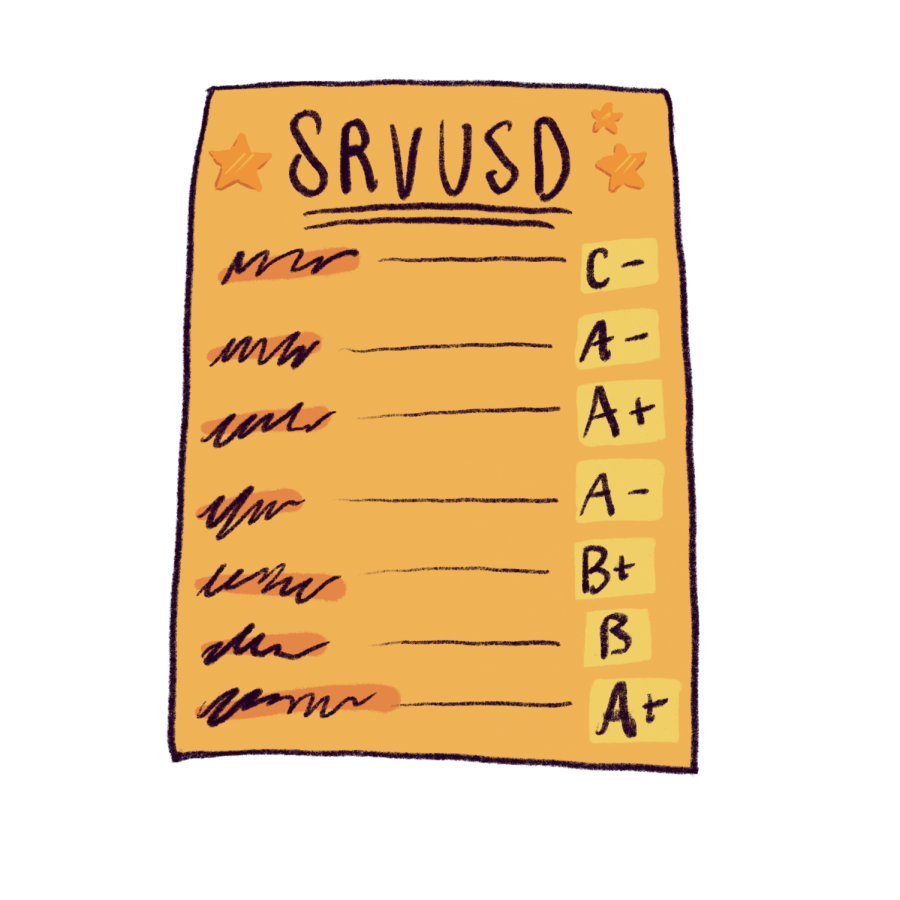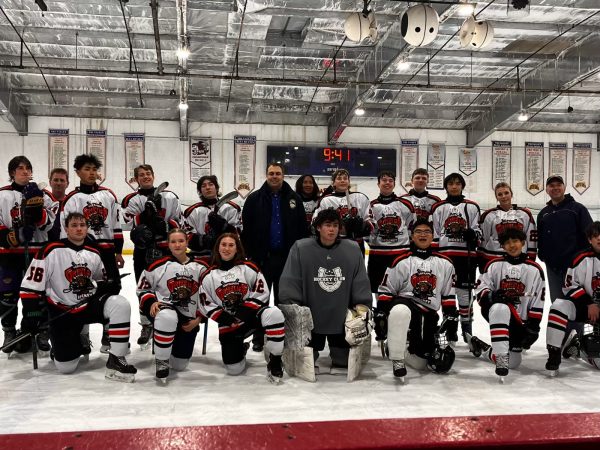Our 2020-21 report card for the Board of Education
The San Ramon Valley Unified School District’s report card, while definitely improving from the first semester, is a mixed bag this year.
Unsigned staff editorials reflect the opinion of the majority of the editorial board.
The Californian published an editorial in December outlining our seven-item wishlist for the San Ramon Valley Unified School District’s Board of Education for the second semester, as well as for the years to come. Now that we are finishing up the school year, it’s time to look back and grade them on their progress on each point and overall, report card style.
- Consistent and honest communication. The first thing we asked for in our December wishlist was clarity in communication from the district. The ambiguity in information about changing policies and guidelines was unacceptable, even with everything going on.
Since then, the district has gotten its act together. Somewhat. It has, for the most part, unified its message and goals in regards to COVID-19 and hybrid and remote learning. But there is still a huge disparity between its goals of communication and reality.
For example, students are notified seemingly at random if they have been exposed to someone who has tested positive for COVID, if they are notified at all. Beyond the notification, the system of how students are determined to be “at risk” is still unclear. Cal High Principal Megan Keefer said in an April email that this phrase can be defined as “people who spend 15 minutes or longer, cumulatively, within six feet of a person infected with COVID-19.” But it’s not clear how lunch is factored into the equation. During this 35-minute period, students gather at any table of their choosing, with no masks, to eat. There is no one keeping record of this, so how accurate can this metric of “exposed and at risk” even be?
This problem is further exacerbated by the lack of uniformity in their messages to teachers versus students. Both parties have frequently found themselves asking each other to explain guidelines or messages, because they have received different communications.
Besides COVID, the district’s largest communication failure was its lack of information provided about AP exams before the refund date. For this year’s tests, each school had a different schedule, and students were not made aware of the specific schedule – or if the test would be in person – until the Monday after the final date to get a refund on the test from College Board. This meant that many students were forced to take a gamble in their decision/refund, regardless of their feelings of safety about taking an in-person test.
Overall grade: C-
- Stop pandering and prioritize health and safety for all. With our minds still fresh from the bias and unprofessionalism of former Board President Greg Marvel, The Californian wanted to make sure that safety was the main priority of the incoming and sitting members of the school board, not personal gain.
Though we had expected that no changes would be made to the start date of hybrid learning, the board voted 5-0 on Dec. 15 to postpone reopening campuses, citing safety concerns. Though some families were outraged, this decision was one of the first times that the district seemed to truly prioritize the safety of its students and teachers over the desire to return to normalcy.
When students did return to campuses on March 16, many teachers had been vaccinated, and COVID-19 cases were occurring at a much lower rate. The pandering had stopped and the board held a strong and united front with their decisions. Any lasting influence of Marvel seemed to have been vanquished, and students and teachers started to feel comfortable knowing that they had a board that was looking out for their well-being.
Grade: A-
- Make informed decisions, and stick to them. The surprise of postponing the return to hybrid learning was a welcome one. Though the district did go back on its original decision, it was for good reason. COVID-19 cases were still spiking, and very few – if any – teachers, students, or staff were vaccinated. The board and district promised that a return would occur when the county reached the red tier, and that we would be immediately ready when it did.
The board followed through with this decision, and (the day before) Contra Costa County was officially in the red tier, students returned to Cal for hybrid learning.
Grade: A+
- Promote student involvement. In this section, we proposed that the board take advantage of section BB 9150 of the district’s Board of Education bylaws, which states that “the board shall include one student board member selected in accordance with procedures approved by the board.” We also suggested that the district assemble “a diverse student advisory committee with representatives from all middle and high schools, led by the new student board member.”
In maybe the most concrete change and adherence to our wish list, the district created a group called the Student Senate a mere few weeks after the running of our original editorial. The senate, which consists of two representatives from most middle and high schools, meet twice per month to discuss issues affecting students. These students are divided into four “umbrellas” focusing on social equity, mental health, online school and Zoom fatigue, and increasing the student voice.
The Student Senate is a huge step in the right direction. We hope that as the years progress, this senate evolves and improves, and ultimately can report to the new student board member, junior Ronit Batra of Monte Vista who was sworn in at the last board meeting. We appreciate the Board of Education finally sitting a student board member after years of ignoring its own bylaws, and look forward to Batra being able to work with the senate as well as other trustees to bring attention to and advance students’ interests.
However, the district must work to make sure that the senate and board seat are successful, by publicizing the positions and viewing them as an equal partner.
Grade: A-
- Work with each of the four high schools to start planning graduation now. While we don’t know exactly when planning began on graduation, we do know that a modified in-person version will occur. At Cal High, graduation will be split into two ceremonies, at 4 and 7 p.m. Each student will be limited to bringing a maximum of four guests from the same household to ensure social distancing can be maintained.
Of course it would have been ideal to only have one graduation ceremony with all of the seniors together, but after a year of remote learning for many students, this will be a welcome way to end four years.
Grade: B+
- Follow through on the promises made to organize safe activities that include remote students. The district made many promises to orchestrate on-campus events this semester, and a few of these promises did come to fruition. Mainly focused on senior bonding, the last couple months of school at Cal included an outdoor movie night, a decision day photo-op, and a modified Senior Ball for the class of 2021. For the many students who had given up hope of ever even stepping foot on campus again, these events were a fun way to safely see their friends before graduation.
Grade: B
- Don’t let the quality of remote learning dip. The Californian was worried that because of the focus on in-person learning, remote learning might be neglected by the board. This was not the case, as most remote students did not have any changes in quality of instruction throughout the semester.
If anything, the quality of hybrid learning was not all like it was hyped up to be. Many students were combined with other classes, put in random locations such as the choir room or new “learning lab,” which meant they were forced to talk quietly in order to not disrupt others. A large portion of classes did not even end up being taught from school, and students just logged onto their class from a classroom, instead of their homes.
Remote learning continued in its full capacity throughout the semester, providing a stability for many during an anything-but-stable year.
Grade: A+
While the process was far from seamless, these last few months could have been A LOT worse. Seniors got a final dance and will graduate with many of their peers, and those who wanted to return to in-person instruction were eventually able to do so.
Sports seasons were successfully orchestrated, and COVID cases were kept to a minimum. And while students may not have had all of the events they wanted, they can take solace in knowing that the reason was because of safety concerns, not any personal vendetta.
In our December editorial, we asked the board and district to use this last semester of remote learning wisely, and to “make it count.” And in a time as crazy as this has been, they pretty much have.
We also said that “the work is far from over,” and we echo these sentiments now. The communication within the district and to students, teachers, and parents has been abysmal at times, and must be improved. The transition to full time, in-person learning will also not be easy, so the board must stay resilient in rebuilding a community scarred by a once-in-a-lifetime experience.
Overall second semester grade: B-

A senior at California High School, Rebecca Newman is a third-year newspaper student and is currently the graphics editor for the Californian. She spends...





